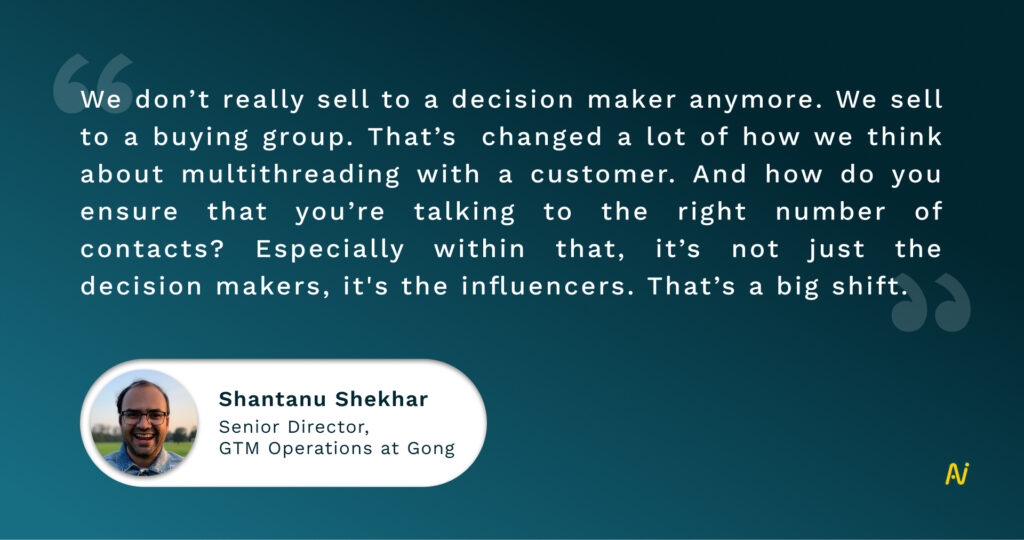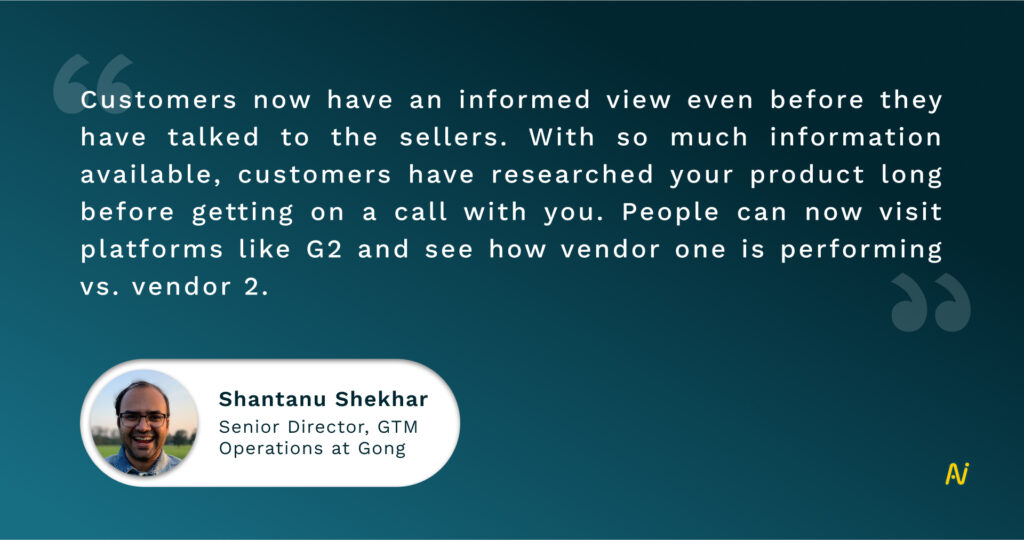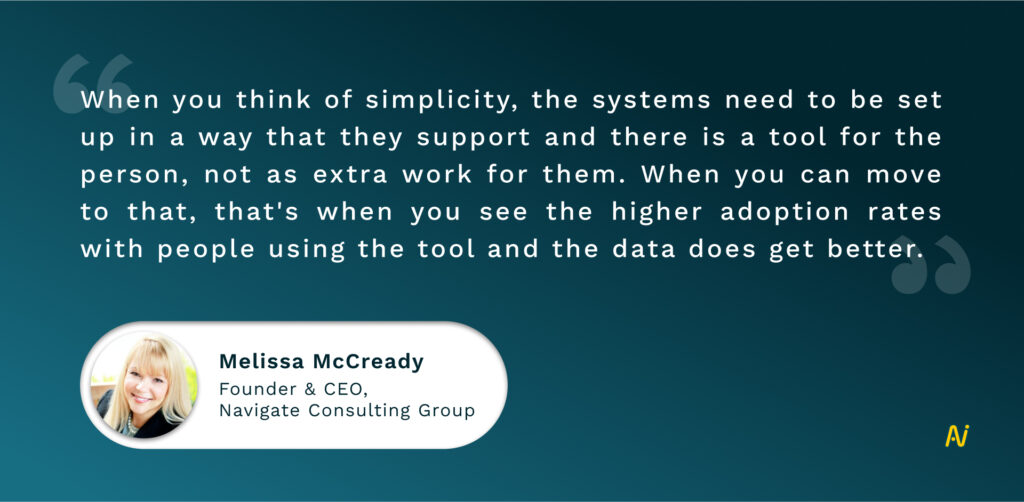
Driving RevOps Growth With B2B Contact Data
Learn how you can drive revenue efficienctly by utilizing B2B contact data with a RevOps first approach. Read on for details.
A B2B buyer is no longer a singular entity. It’s a group of people. More than half of global business buyers purchase in complex buying scenarios that include more people, more departments, and generally higher price points. And the average number of buyers in this group is made up of 7 to 20 people!
But most of this critical contact data is buried in tools that GTM (Go-to-Market) teams use. This data never makes it to the CRM which is considered to be the single source of truth when it comes to driving outbound efficiency or running strategic ABM campaigns.
And the data that does make it to the CRM is subject to getting outdated at a fast pace as people move between jobs. The dependence on manual entry significantly raises the risk of bad data.
Without accurate data about the buying committee, GTM teams miss out on numerous opportunities, leading to visibility gaps in relationships and engagement.
To address this challenge, we explore how revenue leaders or RevOps can effectively manage it in this blog.

Defining Revenue Operations
Revenue operations (RevOps) is based on the principle that revenue generation is not limited to a single department or team but involves various stakeholders across the organization.
While different individuals and companies may have their own interpretations of RevOps, there are three core pillars that commonly define its scope: Go-To-Market (GTM), Core Operations, and Data Insights.

1. Go-To-Market (GTM)
The GTM pillar of RevOps focuses on the strategies, tactics, and processes involved in bringing products or services to market and acquiring customers. It encompasses marketing, sales, customer success, and customer support. The goal is to ensure these teams are aligned and working together efficiently to drive revenue growth.
2. Core Operations
The Core Operations pillar of RevOps is concerned with streamlining and optimizing the operational aspects of the revenue generation process. This includes activities like order management, contract administration, billing, and collections. By enhancing the efficiency and effectiveness of these operations, RevOps aims to eliminate bottlenecks, reduce friction, and improve the overall customer experience.
3. Data Insights
Data Insights are a crucial part of RevOps, enabling informed decision-making and continuous improvement. This pillar involves gathering, analyzing, and interpreting data related to revenue generation processes, customer behavior, market trends, and performance metrics. By leveraging data insights, RevOps teams can identify areas of improvement, uncover revenue opportunities, and implement data-driven strategies.
B2B Selling has Changed
Before we move on to how contact data can be captured effectively to create a seamless buyer journey, it’s important to understand how selling has changed over the last few years.

Influenced by multiple factors, B2B sales has undergone significant changes, including the last three years characterized by the COVID-19 pandemic and an unpredictable economy. When it comes to changes in buyer behavior, here are the top questions RevOps needs to ask to analyze the impact of this change:
1. Who do we sell to?
One notable shift is the transformation of the buyer-seller dynamic. Rather than solely targeting decision-makers, B2B sales now revolve around engaging with buyer groups. This change is driven by the increasing number of interactions buyers engage in before purchasing, which has risen from 17 to 27 interactions, representing a substantial 58% increase between 2019 and 2021.

2. How do we sell to them?
In terms of the selling process itself, the adoption of omnichannel approaches has become crucial in the B2B space. Self-checkout and self-service options, even for significant transactions, have gained prominence. Customers now prefer to buy directly from a company’s website, reflecting the growing importance of digital channels.
Additionally, the prevalence of remote work and the impact of the COVID-19 pandemic have reduced the number of in-person B2B sales meetings. Currently, less than a third of all B2B sales occur through face-to-face interactions, highlighting the shift towards remote sales methodologies.
3. How do they make the buying decision?
The availability of information has significantly influenced how customers make buying decisions in the B2B space. With platforms like G2, customers can access valuable insights into vendor performance and compare different options. This easy access to information empowers customers to form informed views even before engaging with sellers directly.
Consequently, B2B sellers must adapt to this new landscape by providing relevant, transparent information and positioning themselves effectively to meet customer expectations.

Keeping CRM Contact Data Fresh & Pristine
CRM data is dynamic and subject to a lot of changes on a daily basis. On an average, a champion of a deal lasts in a company for 18-24 months. Data decays and a lot of errors continue to infiltrate the CRM, making it a mess.
This makes data hygiene the holy grail of RevOps. So how can RevOps teams continue to ensure that their contact data can stay fresh and up-to-date to the maximum account possible?
For starters, it is essential to understand the various entry points and sources of contact data. These entry points can include manual data entry by sales and customer support teams, data imports from external sources, web forms, and automated data capture from integrated systems like CRM and marketing automation platforms. Contact data can originate from multiple sources, such as website registrations, lead generation campaigns, customer interactions, and third-party data providers.
Related Resource: A RevOps Guide to Conquer Bad Data
Here are a couple of things that RevOps experts suggest:
- When adding data to the system, establish specific criteria and minimum thresholds to ensure the quality and relevance of the information. This can include verifying the accuracy of contact details, validating email addresses, and ensuring that relevant fields are filled appropriately.
- Implement processes and systems to address any gaps in contact data. These may include data enrichment services that leverage external data sources to fill in missing or incomplete information.
- Invest in contact data automation and enrichment tools like Nektar to capture data from various touchpoints, such as email campaigns or web forms, and automatically populate the relevant fields in your CRM.

Dealing with Data Duplication in RevOps
To avoid data duplication and maintain data integrity, it is crucial to implement certain practices that address this issue. Two key pointers in achieving this are establishing an enrichment process and ensuring individual accountability within the organization.
1.Enrichment process
When adding data to your system, it’s important to have an enrichment process instead of simply adding new data without consideration. The enrichment process involves evaluating the existing data for potential duplicates before incorporating new information.
2. Individual accountability
It is essential to make people within the organization accountable for maintaining data quality and avoiding duplication. Assign clear roles and responsibilities for data management and establish guidelines or protocols for data entry and maintenance.

How Nektar Empowers RevOps with B2B Contact Data
It might seem like you need a magic wand to always have pristine contact data in your CRM without lifting a finger. Nektar is that wand.
Nektar’s no-code platform for Revenue Operations automatically synchronizes all contact and sales activity data, eliminating the need for manual data entry by your sales representatives. This synchronization occurs seamlessly, without any additional effort or the requirement to adopt new tools. The platform seamlessly integrates with all the communication and pipeline tracking tools you currently use to engage with prospects and manage your sales processes.

Nektar’s AI-led contact data automation solution gives RevOps teams a unified view of all their contacts, relationships and engagements. So you get:
- Pristine CRM data hygiene on auto-pilot mode
- Higher multithreading success with key contact data information
- Generate accurate performance reports
- Improve conversion rates across the buyer’s journey
- Improve effectiveness of sales execution
- Build a predictable revenue engine, quarter after quarter
Rescue your contact data from the trap of siloed tools. And unlock its true potential with Nektar.

PUBLISHED BY






